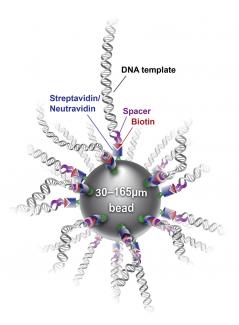A wildly successful JILA (Nesbitt Group)-NIH collaboration is opening the door to studies of RNA behavior, including binding, folding and other factors that affect structural changes of RNA from living organisms. Such structural changes determine RNA enzymatic functions, including the regulation of genetic information.
Yun-Xing Wang of the National Institutes of Health (NIH) and his collaborators developed a novel method for making small RNA strands consisting of dozens of structural units called nucleotides, and also precisely placed radioactive or fluorescent-dye labels in targeted locations along the RNA strand. Then Fellow David Nesbitt and recent JILA Ph.D. Erik Holmstrom used their lab’s single-molecule Fluorescence Resonance Energy Transfer (smFRET) method to prove that Wang’s innovative method for custom-making RNA worked as advertised
Such studies are critically important in science and medicine. Small RNAs play key roles in the biochemistry inside cells. For example, inside a cell small RNAs called riboswitches regulate the production of proteins encoded by messenger RNA and ribozymes, which can catalyze cellular biochemical reactions. Other small RNAs called aptamers are currently under study for drug development, work many researchers hope will also improve the prospects for gene therapy.
Plus, the ability to custom-make strands of RNA may also lead to the creation of designer drugs and RNA-based molecular sensors. The development of new RNA-based technologies and fundamental research in the biophysics of RNA action in cells will both profit from the new method for custom-making RNA.
The new method employed an automated robotic platform consisting of DNA templates (blueprints for a variety of custom-made RNA strands) bonded to a solid bead. The RNAs produced by the robotic platform were labeled with radioactive isotopes (for NMR studies) or fluorescent dye molecules at specifically determined locations (for smFRET studies). The dye molecules allowed Nesbitt and Holmstrom to show that the RNA strands were folding exactly as predicted, confirming the validity of the method developed by Yu Liu, Jason R. Stagno, Jinfa Ying, and Yun-Xing Wang of the National Institutes of Health and their colleagues from the National Heart, Lung, and Blood Institute; Frederick National Laboratory for Cancer Research; and the University of Texas Health Science Center.—Julie Phillips




